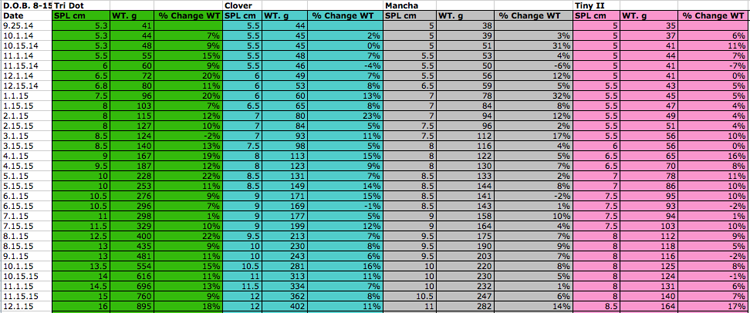Leopard Tortoise Growth Rates
Frequent questions that I see on many tortoise forums is about leopard tortoise growth rates. Thread topics like: “Is my tortoise growing at the proper rate?” or “What is the normal growth rate of leopard tortoises?” seem to pop up on a regular basis. Leopard tortoise owners want to know if they are doing things right and a good indicator of proper husbandry is growth of their pets. The only problem with using growth rates as an indicator of animal health is that this is one of the most difficult aspects to nail down. The reason for this is that tortoise biology, physiology and anatomy is so complex that there is no real steadfast rule to their physical growth rate. Things that can effect their rate of growth include but are not limited to key factors such as hydration, diet, sunlight (UVA/UVB), exercise, stress factors like over crowding, over handling or ‘bullying’ by their enclosure mates, temperatures, genetics, appetite, food type preference, gender, etc etc.

All 4 South African Leopard Tortoises Hatched in August 2014
All individual tortoises grow at different rates and leopard tortoises as a species are no exception. I have seen clutch mates (same genetics) raised in the same enclosure (same environment) have very different growth rates. The main thing that I look for is continue growth for young torts as an indicator of health. You should see growth month over month. If their growth stalls, that may be an indicator of some health or husbandry issue that would need further investigating.
I weigh my hatchlings and juveniles on the first and 15th of each month in grams and measure their length in centimeters represented as SPL (Straight Plastron Length) on an Excel spreadsheet. This give me a good at-a-glance look of how they are growing. Once the data is in an Excel sheet I can plot charts and graphs to further get an idea of their growth. Again I’m more concerned in steady growth whether it be fast or slow is not of any real concern to me.
In the leopard tortoise growth rates chart below, it shows 4 of my South African leopard tortoises that hatched in late August 2014. They were hatched by the same breeder but they are not necessarily clutchmates. The breeder has 12 adult South African leopard tortoises and their clutches are ground hatched once per year in August. So it is possible that these four are related but not probable.

South African leopard tortoise growth rates chart
As you can see, they exhibit dramatically different growth rates. One of the benefits of raising multiple hatchlings is that I can see first hand the diversity each individual shows. If I only was raising Tri Dot who reached a weight of almost 900 grams at 15 months I would have a much different opinion on leopard tortoise growth rates than if I was only raising Tiny II who weighted only 164 grams at 15 months. Personally I feel that both of these tortoises show ‘normal’ growth. They are active, alert, and seemingly very healthy in every way.
The only observation that I’ve made that may shed some light on this large growth variance is the way these two feed. Tri Dot eats like a hungry lion tearing apart a Wilda beast. Taking huge bits at a time a jerking her head to one side as if she is tearing apart some poor animal. She will eat anything I offer her from fresh cut grasses and weeds to pill bugs and everything in between. While Tiny II eats more like a chicken. She will take a few dainty bites then walk around her enclosure then take a few more bits then go under the heat light for a while then wander back over to her food plate for a few more bites.
My conclusion is that some leopard tortoises grow faster and some grow slower than others… simple as that. As long as your leopard tortoise is growing at steady rate then all is good.
